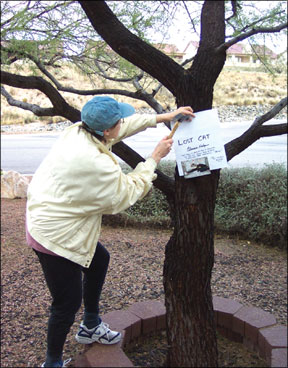Perhaps one of the scariest thoughts for the owner of an indoor-only cat is that of your cat having to fend for himself in the great outdoors. Julia Albright, DVM, a resident in animal behavior at the Cornell University Hospital for Animals, says, “Keeping your cat indoors is the best way to provide a safe environment for him.

288
Outside your home the cat may be exposed to other cats, cars and predators.” However, accidents do happen, no matter how careful we are. A window screen may pop out unexpectedly, or a repairman may leave the door open “just for a second” while he grabs a tool from the truck.
But apart from regularly checking window and door screens and making sure that all visitors know that your cat is strictly an indoor cat, the only thing you can do is prepare yourself for the occasion when he does get out.
Studies show that indoor-only cats often exhibit specific patterns of behavior when they suddenly find themselves outdoors. That is, upon finding themselves in unknown territory, they will often “go into shut-down, self-preservation mode because they are overwhelmed,” according to Dr. Albright. She states, “The cat will not be accustomed to the new sights and sounds and he can easily become overwhelmed and frightened.” So, if you see your cat exit the house, try to keep your eyes on him – once he hides, he may not consider you “safe” anymore, let alone answer your call. Its worth a try to tempt him by shaking food or treats – but dont count on a response. Dr. Albright explains, “Shaking food or tapping on a can of wet food will often increase the cats motivation to come to the owner; however, the cat may be too scared to leave its hiding place to come to you (or it will be too distracted).” Keep in mind, also, that his flight response may kick in if you try to pick him up when hes too overwhelmed, and he may scratch or bite you in an attempt to get away. If hes still in sight but you feel he may dart away, leave your door open (if possible), position yourself carefully on the other side of him, and gradually encourage him to head to familiarity and safety in the house.
If, unfortunately, your cat has had a chance to hide, try not to despair, but do act quickly. Chances are that your cat will be within a two-to-three house radius to begin with, but as time passes, he may venture farther and farther from home. Dr. Albright suggests talking to each of your neighbors directly, posting flyers, searching the neighborhood both day and night, and calling nearby animal shelters.
The most important thing is to look in every possible nook and cranny in that two-to-three house radius: Likely as not, your cat will just be very well hidden underneath your own porch, but too scared to answer your calls. It may also be necessary to set up a couple of humane traps near your house, baited with your cats favorite food and set each night. (You can call your local animal shelter to see if they have any traps you can borrow.) Until you have found the cat, it may be helpful to place his food and water dishes near the door he exited from – this will not only encourage him to stay close, but it may also help him stay nourished.
Perhaps one of the best things you can do for your cat is to make sure he has proper identification before an incident like this occurs. Dr. Albright advises, “Some companies make breakaway collars, but microchipping is the best way to ensure that the cat gets back to you. Animal shelters and vet clinics should have scanners.” She also suggests teaching your cat to come when you call him while in the house: “Most of us do not train our cats, but teaching the cat that come results in a food reward inside will increase the likelihood that the cat will come outside.”
Hopefully, you will never have to search high and low outside for your cat. But if you do, these suggestions may help increase your odds for a happy reunion.



